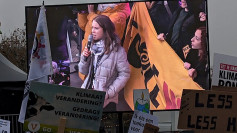India's Prime Minister Narendra Modi on Tuesday disclosed that his government will release 20 trillion rupees ($266 billion) to help an economy ravaged by a large-scale week-long lockout to combat the novel coronavirus in fiscal and monetary steps.
The country has over 70,000 cases among its 1.3 billion people and is expected to exceed China, the source of the pandemic, in a week's time. Modi said a new set of policies would expand the existing stay-at-home orders beyond May 17.
Modi said this initiative for a "self-dependent India" was aimed particularly at the nation's farmer workers and laborers. The program will also help the middle class which pays taxes and contributes to the government's development, the prime minister said during a 30-minute nationwide address.
Finance minister Nirmala Sitharaman, Modi said, would share information about the financial program starting Thursday. This Rs20 lakh crore package includes the various steps announced in the wake of the outbreak, including the Rs50,000 Crore Special Mutual Fund Liquidity Facility declared on April 27 by India's central bank.
India entered its sixth week of a strict countrywide lockdown on Tuesday, dragging an economy already weakened prior to the outbreak to the edge of collapse. The prime minister stated that details of the financial stimulus would be released in the next few days.
According to early reaction from a number of market participants, the initiatives are interesting in their magnitude, should improve investor confidence in the country's capacity to deal with the financial consequences of the coronavirus crisis and offer currency aid. Still, further details are needed, particularly on how to finance the program, they said.
In early trading Wednesday, stock futures on India's NSE Nifty 50 Index traded in Singapore climbed, and dollar-rupee one-month non-deliverable forwards retreated.
The government disclosed it was rolling out some 1.7 trillion Indian rupees ($22.6 billion) in direct financial transfers and food security measures last March, primarily for the marginalized, but was largely accused of doing too little.
The financial relief will also focus on land, liquidity and government policies. It will provide assistance to different sectors including the cottage industry, small and medium entities, the middle class, factories, to name a few.
In his third telecast address since March 23, Modi praised the country's efforts in handling the crisis and stated it has turned the misery into an opportunity. Prior to the pandemic, "we did not have PPEs (personal protective equipment) or enough N95 face masks," he said. "Now we're making at least two lakh of PPEs on a daily basis."






